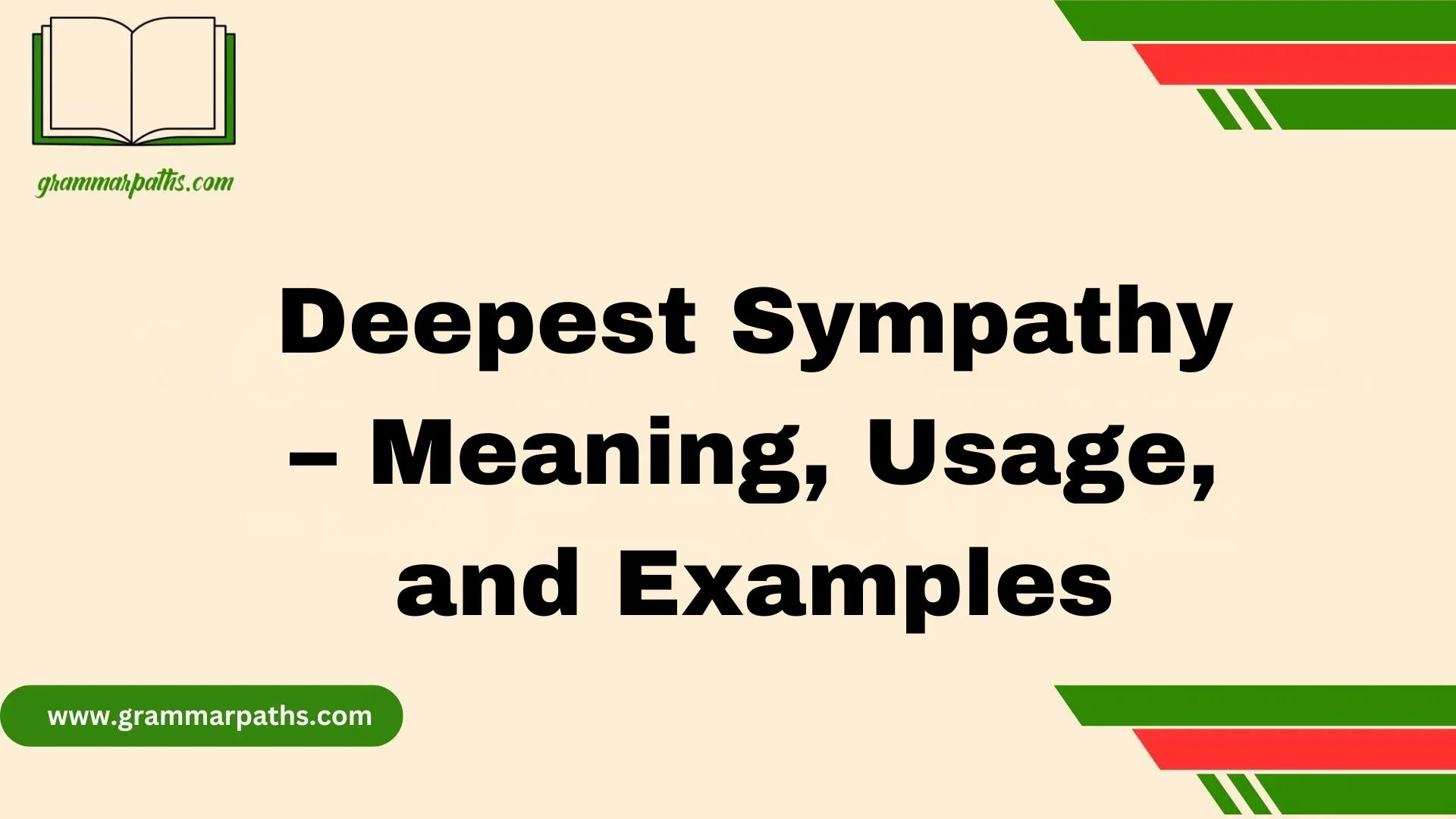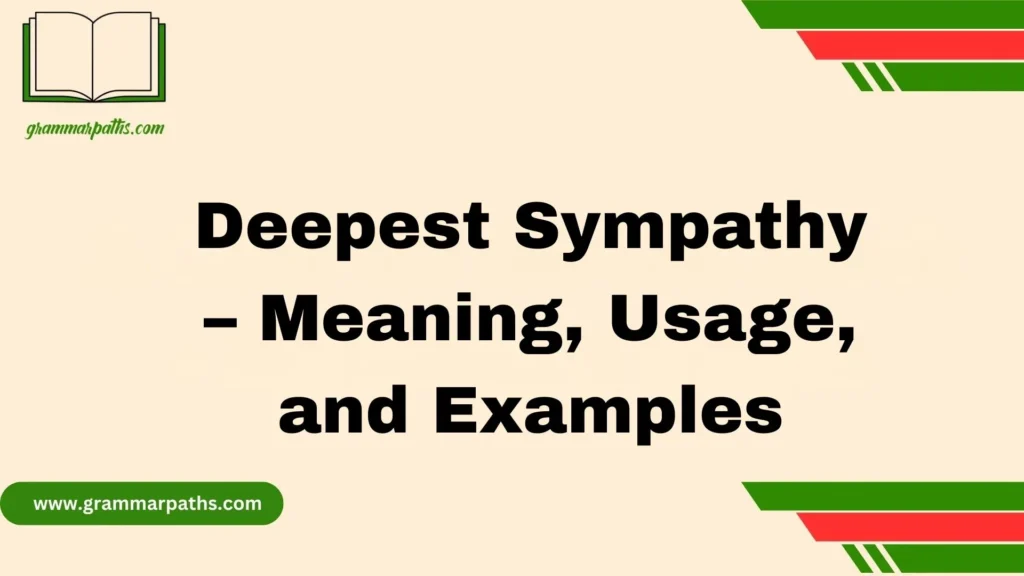Sharing deepest sympathy in tough times takes more than polite words; it carries the power to ease sorrow. Whether through a condolence card, a professional gesture, or public support, even a simple phrase can offer depth, empathy, and comfort. I’ve seen how showing respect and building a genuine connection in mourning brings light to heavy grief and sorrow. A message that’s spoken gently or written with kindness and understanding carries grace and helps lift the emotional burden of loss.
From my own experience, a thoughtful expression of care, even in a short sentence, becomes more than a habit—it turns into a bridge of sincerity and care. When the bereaved feel seen, heard, and valued, a note filled with heartfelt communication becomes a lasting source of acknowledgment. In these delicate moments, real compassion shines, and every sentiment, no matter how small, can lead to meaningful action that comforts those who need it most.
What Does “Deepest Sympathy” Really Mean?
At its core, “deepest sympathy” is an expression of shared sorrow. The word sympathy comes from two Greek parts: syn (together) and pathos (feeling). Put simply, it means “feeling with someone.” When you say “deepest sympathy,” you’re going beyond surface-level acknowledgment. You’re telling someone you recognize their pain and you’re standing with them in their grief.
It’s often used:
- After the loss of a loved one
- During times of tragedy or disaster
- In official statements of condolence
- In personal messages of comfort
The addition of “deepest” makes the expression stronger. It suggests not just ordinary sympathy, but profound and heartfelt sorrow for what the person is going through.
Think of it this way: if sympathy is like placing a hand on someone’s shoulder, deepest sympathy is embracing them with your heart, even if only through words.
Etymology and Origins of “Sympathy”
The term sympathy has deep roots.
- Greek Origin: The word combines syn (together) and pathos (emotion, suffering).
- Early English Usage: By the 16th century, sympathy entered English to describe shared feelings—joy as well as sorrow.
- Shift Toward Grief: Over time, the word became closely tied to compassion during hardship or loss.
The phrase “deepest sympathy” emerged as a standard expression of condolences in the 19th century, especially in written form like letters and obituaries. During the Victorian era, a time when mourning rituals were highly formalized, people used set phrases to convey condolences. “Deepest sympathy” became one of the most enduring because of its simplicity and sincerity.
Related Terms and Nuances
Understanding “deepest sympathy” is easier when you compare it with similar words.
| Term | Meaning | Key Difference from Sympathy | Example Use |
| Sympathy | Feeling for someone’s hardship | Recognizes suffering without necessarily sharing it | “I feel sympathy for her loss.” |
| Empathy | Feeling with someone, as if experiencing their emotions | Deeper, more personal connection | “I empathize with your grief because I’ve lost a parent too.” |
| Compassion | Desire to help relieve suffering | Goes beyond words to action | “His compassion led him to support the family financially.” |
| Pity | Sense of sorrow often mixed with condescension | Seen as less respectful or even insulting | “She pitied him for being alone.” |
The key takeaway: Sympathy comforts with words, compassion acts with help, empathy shares the pain, and pity distances.
When and How to Express “Deepest Sympathy”
The phrase “deepest sympathy” fits different contexts, but how you use it depends on the situation.
In Personal Conversations
- Talking to a grieving friend: “Please accept my deepest sympathy. I’m here if you need anything.”
- Speaking with a family member: “With deepest sympathy, I want you to know we’ll get through this together.”
In Professional Settings
- A workplace email: “On behalf of our team, we extend our deepest sympathy to you and your family.”
- Client communication: “We offer our deepest sympathy for your loss and wish you strength during this time.”
In Writing
- Sympathy cards: Short, heartfelt notes such as “With deepest sympathy, may you find comfort in the love that surrounds you.”
- Obituaries and memorials: Formal acknowledgments like “We express our deepest sympathy to the family of…”
Cultural Considerations
- Western traditions: Often verbal or written condolences, flowers, or attending memorials.
- Eastern traditions: May include rituals, offerings, or group mourning. For example, in Japanese culture, words are chosen carefully to avoid causing additional sorrow.
The golden rule: match the tone to the situation and relationship.
Examples of Using “Deepest Sympathy” in Sentences
Here are practical ways to use the phrase across settings:
Formal Examples
- “We extend our deepest sympathy to the victims’ families during this time of sorrow.”
- “With deepest sympathy, we remember his dedication to our community.”
Personal Examples
- “My deepest sympathy for your loss. Your father was a remarkable man.”
- “Please accept my deepest sympathy. I’ll always be here to listen.”
Alternative Phrasings
- “With heartfelt condolences”
- “My sincere sympathy”
- “Thinking of you during this difficult time”
- “Sending love and prayers”
Common Phrases That Include “Sympathy”
People often pair “deepest sympathy” with related expressions:
- “Please accept my deepest sympathy”
- “With deepest sympathy and prayers”
- “Extending deepest sympathy and heartfelt condolences”
- “Our deepest sympathy goes out to you and your family”
These are especially common in sympathy cards, obituaries, and public statements.
Expressions Beyond Words: Showing Sympathy in Action
Words matter, but actions often speak louder. Expressing “deepest sympathy” can extend beyond language.
Acts of Kindness
- Preparing meals for the grieving family
- Offering to help with errands or childcare
- Donating in memory of the deceased
Nonverbal Expressions
- A gentle hug or holding someone’s hand
- A silent presence at a funeral
- A compassionate nod when words aren’t enough
Digital Age Condolences
- Posting respectful messages on social media
- Sending e-cards or memorial flowers online
- Attending virtual memorial services
Case Study: During the COVID-19 pandemic, many families couldn’t gather for funerals. Digital condolences, though once considered impersonal, became a lifeline for grieving communities. Sending “deepest sympathy” via video calls, online tribute pages, or group chats allowed people to feel connected even when physically apart.
Why Saying “Deepest Sympathy” Matters
Grief can feel isolating. A sincere expression like “deepest sympathy” reminds the grieving person that they’re not alone.
- Emotional Support: It reassures them that others recognize their pain.
- Social Bonds: It strengthens connections between friends, families, colleagues, and communities.
- Psychological Impact: Studies in grief psychology show that acknowledgment of loss reduces feelings of isolation and aids in healing.
As one bereavement counselor put it:
“The words you speak won’t erase grief, but they remind the grieving heart that it doesn’t have to suffer in silence.”
Common Mistakes to Avoid
Even with the best intentions, sympathy messages can sometimes miss the mark. Here are pitfalls to avoid:
- Overused clichés: Phrases like “They’re in a better place” may sound hollow.
- Making it about yourself: Don’t shift focus to your own experiences unless it directly offers comfort.
- Using pity instead of respect: Saying “I pity you” creates distance rather than connection.
- Too much detail: Avoid graphic references to the loss. Keep it simple and compassionate.
Better approach: be genuine, brief, and kind.
Conclusion
Expressing deepest sympathy is never just about the right words—it’s about showing genuine care in tough times. Whether through a simple condolence card, a note, or spoken message, your kindness, compassion, and sincerity can ease the emotional burden of loss. By offering support, you give the bereaved a sense of being seen, heard, and truly valued, turning a delicate moment of mourning into one filled with connection, respect, and meaningful action.
FAQs
Q1. What does “deepest sympathy” mean?
It’s a respectful expression of empathy and comfort for someone going through grief or sorrow.
Q2. How do I use “deepest sympathy” in a sentence?
You can write, “Please accept my deepest sympathy for your loss,” in a note, card, or message.
Q3. Can “deepest sympathy” be used in professional settings?
Yes, offering condolence in a professional or public context shows understanding, kindness, and acknowledgment of another’s pain.
Q4. Why are sympathy messages important?
They help create a lasting sense of support, acting as a bridge of communication and a genuine source of comfort.
Q5. What should I avoid in sympathy messages?
Avoid making the expression sound like a routine habit; instead, keep it heartfelt and filled with real sentiment.

Mia Rose is the passionate writer and founder of GrammarPaths.com, a resource dedicated to helping learners master English grammar, idioms, and writing skills with ease. With a deep love for language and years of experience in teaching and content creation, Mia simplifies complex grammar rules into clear, practical guides that readers can instantly apply.












